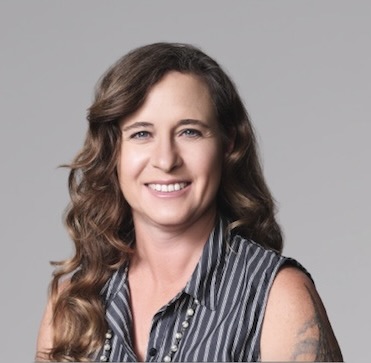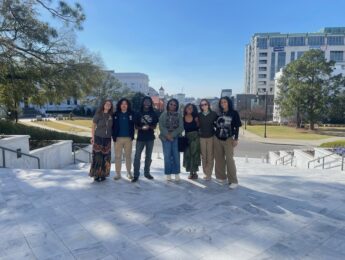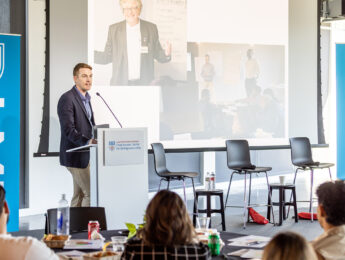
Being a journalist now seems more necessary than ever before, especially in current global geopolitics that continue to affect us in new ways. Yet, external pressures and turmoil within the business, including precarious job prospects and changing standards of news coverage, have left many commentators seeing the end of journalism as we know it. Those are the formidable circumstances that Loyola Marymount University’s growing journalism program is educating students to meet and thrive in.
“It’s a very challenging environment right now, but also quite compelling,” said Evelyn McDonnell, professor of journalism at LMU.

At its core, being a journalist is a vocation, a calling; the field itself continues to shift, especially with the introduction of digital storytelling, the role of social media, and, with the pandemic, the immense popularity of podcasts as a way of reaching the public directly. But change is not new to journalism, and the field itself will likely continue to be shaped by technological and social advances that make it possible for more people to have tools and resources to tell their stories widely.
Visual journalism, in particular, plays a big role in how news is reported today. The term can refer to many different styles, including photography and video, while also providing a journalistic process and framework in any given publication. It can also mean data visualization, graphic design for media outlets, illustrations, and more.
“I think we’re living in a time that is the most visual period of human history, where we’re constantly bombarded by images throughout the day,” says Tara Pixley, associate professor of journalism at LMU, who specializes in visual journalism. “Visual media literacy is an essential part of becoming a journalist.”
Becoming a journalist, in fact, requires a range of abilities: one needs to be able to conduct reporting from the field; gather all the information in an accurate manner; pursue varied perspectives necessary for the telling of the story; as well as be able to present the information in a compelling way to the audience. It requires developing skills that go beyond the newsroom: earning the trust of the communities and the people whose stories are being told, and a deftness that would allow for a kind of discernment that can only be acquired with hands-on experience.
However, given the change in the political climate the U.S. has seen over the past several decades or so, the field has been under siege, especially with the rise of the term “fake news,” which has been leveled at various media organizations. There is also a substantial generational gap between people who read lengthy news articles, and those who expect their news to be presented in a succinct, bite-sized format. Because there are more elements always seeking our immediate attention — including the whirlwind of social media — audiences have grown more impatient with the ways they choose to receive news, which is a new challenge for the field itself.
Visual journalism in particular plays a big role in how news is reported today. The term can refer to many different styles, including photography and video, while also providing a journalistic process and framework in any given publication.
“This is what we have to face as practitioners and educators ourselves,” said McDonnell, “Journalism has never been more important, never has the reporting of actual facts and information been more important for the continuation of our democracy, our culture, our society. It’s more urgent than ever, but it has also become more dangerous.”
A dramatic shift in recent years has seen unethical players in the media continue to spread misinformation, attacking journalists verbally and sometimes physically, and question fact reporting in unprecedented ways. Perhaps this is exactly why it’s so encouraging to see the interest students have shown in pursuing journalism at LMU, which has increased substantially over the past few years, leading the program itself to become its own department. The journalism department, which includes award-winning journalist faculty members such as Pixley, McDonnell, Kate Pickert, Carol Costello, and more, has been cultivating a remarkable group of students by sending them out in the field, connecting them to communities and individuals whose stories transmit issues of social, political, cultural, and moral import. It is a rigorous, interdisciplinary program that incorporates instruction in film, television, photography, and radio production; communication studies, digital media, and modalities not yet known or articulated, an indication of the development of the field itself.
Virtual reality, for instance, is one of the evolving fields that is impacting journalism in interesting ways. “If we’re careful with it, I think virtual reality can make news coverage interesting,” said Costello, a former CNN anchor and lecturer at LMU. Although there may be problems associated with virtual reality, it’s still a way to show people how to inhabit different perspectives in a way that is unique, a way that can create more open-mindedness, more empathy for one another, and more trust in the field itself. Like any new technological advancement that is still shaping itself, virtual reality presents a realm of possibilities that are exciting for journalists; it presents new modalities of providing news and stories that can feel more real, more visceral – a way of bringing news directly to the audience, through tools they’re excited to experience.
Today, a lot can be said about the precarious state of journalism, and where it may be headed in the near future; at its best, journalism seeks to provide us with accurate and compelling information, so that readers are able to discern for themselves and make decisions about their future without being swayed one way or another. At its best, journalism is also a tool for truth-telling, no matter the medium. Though there are many ways to be caught in disinformation, journalism still thrives because it continues to tell our stories in an accurate way.
That’s why perhaps it’s now more important than ever to work actively to represent different perspectives in the media, utilizing all the tools and resources to pursue stories from underserved and marginalized communities, and continuing to educate students so they can develop critical thinking, explore ethical issues affecting our communities today, and become the objective, skilled, discerning citizens we need them to be.










